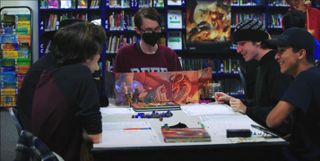Dungeons & Dragons is a powerful teaching tool say educators who have used it as part of their curriculum or for after-school clubs.
The tabletop role-playing game debuted in the 1970s but is currently experiencing a renaissance. This is due in part to the prominent references to the game on Stranger Things and the popularity of Dungeons & Dragon web streams and TV series, including Critical Role, a web series featuring voice actors playing the game that inspired the Amazon animated series The Legend of Vox Machina.
Educators can capitalize on this popularity by facilitating students as they embark on noble quests filled with magic, dragons, and warriors. At the same time, students will get better at reading, math, problem-solving, collaboration, and more.
Here are some of the reasons educators say they teach with Dungeons & Dragons.
1. Dungeons & Dragons Can Teach Social-Emotional Learning
Kade Wells, Harrisburg North Middle School ELA Instructor in South Dakota and founder of Building Heroez, says Dungeons & Dragons helps students with their social-emotional growth because it gets them away from screens and has them collaborating with one another IRL (in real life).
“When they are sitting around the table playing, they're working on their personal communication skills,” he says. “I've seen it change kids’ lives pretty drastically. You have the fly-on-the-wall kid who never says anything in class, and they'll become an advocate for themselves and others.”
2. D&D Helps Students Develop Reading Skills
Dungeons & Dragons can be an interactive and engaging way to teach students how to start to understand and analyze complex texts. “A lot of the manuals are at a very high Lexile level,” says Lizz Simpson, a middle school librarian at Sudbury Public Schools in Massachusetts. Simpson says students who play the game naturally break down complex texts dealing with different rules around things like casting spells.
Wells agrees. “You have to synthesize the information in order to utilize the information, which increases the synaptic path growth from theoretical to concrete,” he says. “When kids do this over and over and over again, that synaptic path becomes an optic highway. Sort of magically, there'll be a point where everything kind of clicks and those students will be able to glean information quicker, answer questions faster, and become better problem solvers.”
Currently, Dungeons & Dragons is built into the curriculum of Wells’ classes but he started using it as a reading intervention for students who had experienced trauma or had other language acquisition challenges.
3. D&D Fosters Collaborative Creativity and Storytelling
“The core element of Dungeons & Dragons is collaborative storytelling,” says Zac Clay, a music teacher and D&D Club volunteer at Benecia Middle School and Benecia High School. Playing the game gives the students the chance to express their artistic sides whether that’s through developing their characters or by drawing maps and other scenes associated with gameplay.
“It has created an outlet for them in the school space to be able to express their creativity,” he says. In contrast during the rest of the school day, “they may just be in taking in a lot of information and don't really get a chance to actually express themselves.”
At the same time that they get this opportunity for collaborative expression, they’re also learning critical thinking and problem-solving skills.
4. D&D Provides Opportunities for Math Practice
Many-sided dice play a role in much of the action in Dungeons & Dragons and tallying these dice scores takes quite a bit of recursive math, Wells says. “Even for kids who are good at math, this sort of adding two numbers together all the time, all the time, all the time, makes them just better.”
Clay says a math teacher could even go further than adding up the dice by building more advanced math problems into the storytelling of the game. “Maybe the way for students to attack the goblin is to solve the quadratic formula or something like that,” he says.
5. D&D Can Help With Socialization and More
One of the primary draws of Dungeons & Dragons in the school setting is that it allows students to socialize in a manner that’s different from any other school interaction. “The whole point is to sit around a table with your friends, and not just chat about random stuff, but to actually work together on a goal,” Clay says.
Simpson has seen middle schoolers make friends playing the game and learn how to have fun and accomplish goals in a group. “[They learn when] to take turns and sit back and let somebody else take the floor because they have a more important skill for this particular challenge,” she says.
Wells has witnessed Dungeons & Dragons being an effective teaching tool for students who have experienced trauma or are on the autism spectrum. “I've seen it bring kids back from the brink of trauma,” he says. “I've had students when I taught in Texas who had family members that lived in Honduras and terrible things have happened to them. And students have been disengaged, and then all of a sudden, they're part of this community, and they completely turned around.”
Resources
Educators interested in bringing the game to their classroom or school as a club activity can get a free D&D Afterschool Kit and search a wealth of resources at the Dungeons & Dragons educator’s page.
Teachers who are new to the game hoping to get a better understanding of it might want to watch some members of the cast from Stranger Things playing a game hosted by B. Dave Walters.

